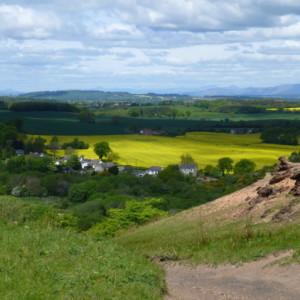Niddry Castle
As an extra outing from the U3A Geology group sixteen of us were given a tour of Greendykes Bing. near Broxburn in West Lothian, by Dr Barbra Harvie, who provided us with a summary of her detailed report.
The bings were created as the spoil, called blaes (pronounced 'blaze'), from the oil shale industry and Greendykes is the biggest remaining of the original 19. The bings appear to be red as a result of oxidation on the surface of the natural colour, which is blue/grey, hence the name (blaes = blues).
The bing has an alkaline substrate, unlike the surrounding farmland, and our talk emphasised the environmental differences from other spoil types, such as coal slag heaps and how this is reflected in the biodiversity. For example, blaes is non-toxic, contains no heavy metals and the particle shape renders blaes stable and free-draining, so bings do not suffer from landslips. It is too sharp for rabbits to burrow but there are hares which 'nest' above ground. However, there are differences between individual bings of identical composition which are difficult to explain.
Although steep-sided (our ascent followed the route of the trucks that delivered the spoil), the top of Greendykes is a plateau with views in all directions. My blip is of Niddry Castle, a typical C14 Scottish tower house which has connections to Mary, Queen of Scots. An extra photo shows the view looking northwest.

Comments
Sign in or get an account to comment.


